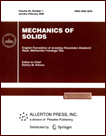 | | Mechanics of Solids
A Journal of Russian Academy of Sciences | | Founded
in January 1966
Issued 6 times a year
Print ISSN 0025-6544
Online ISSN 1934-7936 |
Archive of Issues
| Total articles in the database: | | 13288 |
| In Russian (Èçâ. ÐÀÍ. ÌÒÒ): | | 8164
|
| In English (Mech. Solids): | | 5124 |
|
| << Previous article | Volume 60, Issue 4 / 2025 | Next article >> |
| Meng Li, Haotong Zhao, Shuai Gao, Ruifeng Liu, Binbin Hao, Pu Gao, and Peng Wang, "Study on the Guiding Law of Holes on the Crack Propagation Behavior under Impact Load," Mech. Solids. 60 (4), 2980-2999 (2025) |
| Year |
2025 |
Volume |
60 |
Number |
4 |
Pages |
2980-2999 |
| DOI |
10.1134/S002565442560165X |
| Title |
Study on the Guiding Law of Holes on the Crack Propagation Behavior under Impact Load |
| Author(s) |
Meng Li (School of Mining and Geomatics Engineering, Hebei University of Engineering, Handan, 056038 China)
Haotong Zhao (School of Mining and Geomatics Engineering, Hebei University of Engineering, Handan, 056038 China, 17852979006@163.com)
Shuai Gao (School of Mining and Geomatics Engineering, Hebei University of Engineering, Handan, 056038 China)
Ruifeng Liu (School of Civil and Architectural Engineering, Panzhihua University, Panzhihua, 617000 China, liuruifeng19880209@163.com)
Binbin Hao (School of Mining and Geomatics Engineering, Hebei University of Engineering, Handan, 056038 China)
Pu Gao (Xingdong Mine, Jizhong Energy Group Co.Ltd., Xingtai, 054000 China)
Peng Wang (School of Mining and Geomatics Engineering, Hebei University of Engineering, Handan, 056038 China) |
| Abstract |
There are a large number of primary and regenerated defects in the rock mass of deep underground engineering, such as primary joints, regenerated cracks and geological holes. When the cracks are subjected to external loads, especially dynamic loads, the dynamic fracture phenomenon will occur. The uncontrolled propagation of cracks will further aggravate the fragmentation of roadway surrounding rock and reduce its stability. To this end, this article simplifies geological fractures into a prefabricated crack and anchor bolt drilling into a single circular hole, thus constructing three types of single crack single hole board experimental configurations (SCSH) with horizontal, vertical, and single hole size variations. The Split Hopkinson Pressure Bar test system (SHPB) is used to explore the influence of single hole on the dynamic fracture behavior of cracks under dynamic load. The effect of physical experiment is verified by the explicit dynamic software AUTODYN, and its influence mechanism is further explored. The results show: (1) as the distance between the circular hole and the tip of the pre-crack increases along the crack direction and propagates to the vicinity of the circular hole, the propagation path tends to the hole; (2) as the increase of vertical distance between hole and pre-crack, the guiding stress field at the tip of the propagating crack and the guiding effect of the hole on the crack are both gradually decrease; (3) with the diameter increase of the hole, which presents a significant guiding phenomenon for the crack dynamic propagation, however, when the hole diameter is less than a certain value, it will have no guiding effect on crack propagation. The research results of this paper can provide strong theoretical support for the corresponding prevention and control measures to ensure the stability of roadway surrounding rock in underground impact pressure mines. |
| Keywords |
Dynamic load, Circular hole, Crack dynamic fracture, Crack guidance, SHPB |
| Received |
09 April 2025 | Revised |
22 May 2025 | Accepted |
23 May 2025 |
| Link to Fulltext |
|
| << Previous article | Volume 60, Issue 4 / 2025 | Next article >> |
|
 If you find a misprint on a webpage, please help us correct it promptly - just highlight and press Ctrl+Enter If you find a misprint on a webpage, please help us correct it promptly - just highlight and press Ctrl+Enter
|
|

 Russian
Russian  English
English